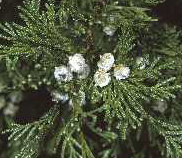 |
On-line Proceedings of the
2009 Atlantic White-Cedar Symposium
The Ecology and Management of
Atlantic White-Cedar (Chamaecyparis thyoides) Ecosystems
A Symposium held on June 9, 10, and 11, 2009 at the
City Hotel and Bistro in Greenville, North Carolina - USA |
Toxic and Medicinal Potential in Atlantic White Cedar Wetland Forests
Aimlee Laderman and Pamela Polloni, Marine Biological Laboratory.
Presentation given by Dr. Aimlee Laderman
Dr. Laderman has a career-long dedication to increasing basic knowledge and public awareness of Atlantic White Cedar (AWC) forested wetlands. In 1984, she organized and chaired an AWC Symposium, bringing together workers in this field for the first time. She is Director of the Swamp Research Center in Woods Hole, Massachusetts, and has authored and edited 3 books and many articles dealing with AWC and related subjects. Her laboratory currently concentrates on studies of the algae and other microscopic life in acid wetlands. These data are fed into the Universal Biological Indexer and Organizer of the WHOI/MBL Library and Herbarium; she also contributes AWC information to the global Encyclopedia of Life. As a consultant, Laderman advises Federal, State and local agencies on wetland issues, and designs and directs the restoration of freshwater wetlands. In 2002, she retired from the faculty of Yale University School of Forestry and Environmental Studies after a dozen years of teaching environmental restoration and wetland ecology. Laderman and botanist Pamela Polloni are preparing an interactive state-based biogeographic database of the plants in all AWC forests.
Toxic and Medicinal Potential in Atlantic White Cedar Wetland Forests
Abstract: Plants and animals surviving in extreme environments, such as cedar swamps, have developed adaptations to particular stringent conditions. Poisonous components, such as alkaloids and resins, are among the adaptations found in extremophiles. Many effective drugs are derived from chemical components that are poisonous at higher doses, or in modified forms. This study aims to determine which plants associated with Atlantic white cedar (AWC) (Chamaecyparis thyoides, L.BSP) are in families with known medicinal or toxic properties, for species within a family share a significant number of genes and characteristics. Four of the families in cedar swamps are known to have poisonous or pharmaceutical components.1) Ericaceae (heaths): Some parts of all Ericaceae may cause severe problems to man and animals when ingested, although many of their fruits are edible (e.g., blueberries, cranberries), and some are ancient herbal remedies. Forty-four spp. in 16 genera co-occur with AWC, distributed in all the 15 states where cedar swamps are found. Ericaceae are often the most diverse and abundant family in an AWC wetland forest. 2) Araceae (aroids, calla): Six spp. and 2 subspp. in 5 genera are found in 11 states, e.g., Jack-in-the-pulpit, Arrow-arum. All 8 spp. cause problems when ingested e.g., allergic anaphylaxis, itching. 3) Liliaceae (lilies): Nineteen spp in 16 genera are found in 12 states. One genus, Zigadenus, in Western FL,is extremely toxic. 4)Solanaceae (potato): The sole species, Solanum dulcamara (False Bittersweet), in NJ, is highly poisonous. Liliaceae and Solanaceae may contain both toxins and teratogens. Seventy-three species associated with C. thyoides are in families with known toxic or pharmaceutical properties. This medicinal potential is worth exploring.
Proceedings Table of Contents and Conference Links
